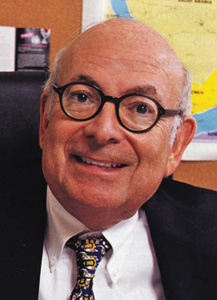Remembering camp for Jewish kids exposed to tuberculosis
Published November 28, 2012
Mickey Rosen, the high energy executive director of the Simon Foundation, is the picture of health. In fact, for decades he has been a regular at the Jewish Community Center, enjoying not only working out in the gym, but playing cards and schmoozing with his long-time friends. But when Rosen, now 79, was a child of five, he was a skinny and sickly kid, having been exposed to tuberculosis, the horrific disease that ravaged the nation before the development of effective treatments of more recent years.
Rosen and Jewish kids of his generation were blessed to have access to “Camp Fee Fee,” or more officially, the Summer Preventorium, a program sponsored by the Jewish Sanitarium, which was established in 1910 and opened in 1914.
The Jewish Sanitarium, which was located on Fee Fee Road in St. Louis County, and which was supported by United Charities (now the United Way) through the Jewish Federation, was established to give adequate nursing and medical service and full maintenance to anyone suffering from any chronic disease, including lodging, board and complete medical services. The facility accepted Jewish persons suffering from any chronic disease, the majority of whom either had or were exposed to tuberculosis.
In order to provide for the special needs of children with, or exposed to, TB, the Sanitarium, which had 24 beds for chronic invalids and 52 for TB patients, created and sponsored, the Summer Preventorium in 1926, for a total of 32 children, 16 boys and 16 girls. The program, which was informally called “Camp Fee Fee,” accepted an entirely new group each year. Service included full maintenance, lodging and board, playground activities under specially qualified supervisors, health education and complete nursing and medical service.
Rosen, in a recent interview, recalled with affection his days at the facility, where kids with, or exposed to, tuberculosis could have a normative summer camp experience in a bucolic and secure setting.
“The Sanitarium consisted of a colonial-style main building with a pillared porch and an extension with enclosed second-story porches. A second building, the Shoenberg Memorial, resembled a Spanish mission in its design,” he said.
“Much more important than the physical facilities was the superb and sensitive staff, the high quality of medical care, both curative and preventive and the wonderful experience the Preventorium, Camp Fee Fee provided for the 32 kids who took part each summer. We could forget about the worries of a very serious illness or possible exposure to it, and have as close to the same kind of Jewish camping experience as kids at the mainstream Jewish camping programs. I feel very blessed to have shared that experience with so many others in our community who benefitted from it,” Rosen added.
Although two-thirds of the entire Jewish Sanitarium’s beds were occupied by TB patients in the 1930s, a 1939 study showed that such cases were steadily decreasing, while other forms of invalidism were on the rise. Of note is the fact that in recent years TB has made somewhat of a comeback, including an especially virulent strain that does not respond as well to various medications developed over the years.
In the mid-1940s, discussions began regarding the possible combining of various Jewish health services. During this process, the previously separate Reform Jewish Home for Aged and Infirm Israelites was merged with the Jewish Orthodox Old Folks Home into the Jewish Center for Aged.
In 1951, a Community Health Plan resulted in the merger of the Miriam Rose Bry Convalescent Hospital in Webster Groves, the Jewish Medical Service Bureau, and the Sanitarium with Jewish Hospital. By Oct. 10, 1956, all of the Sanitarium’s patients had moved to Jewish Hospital.















